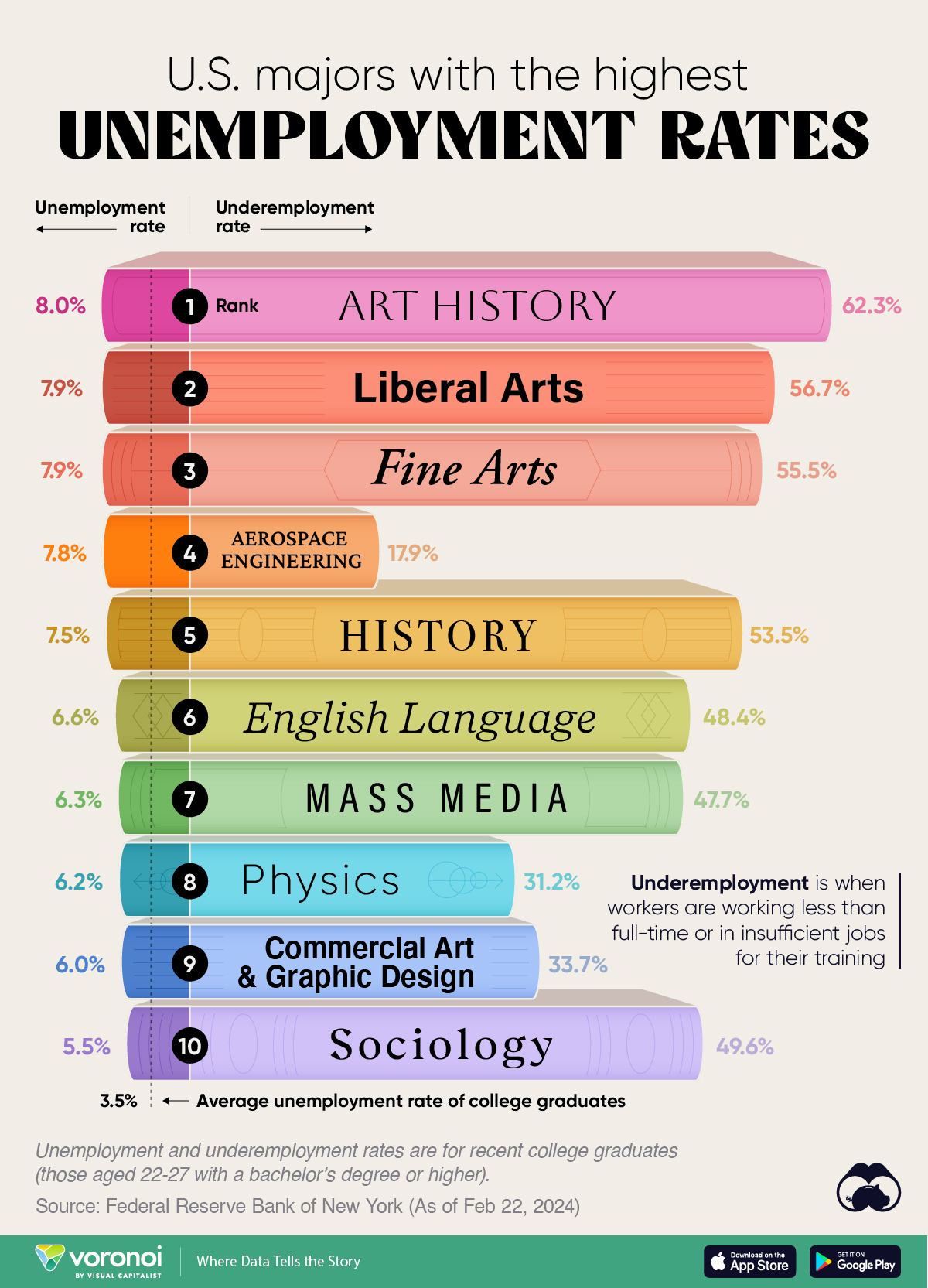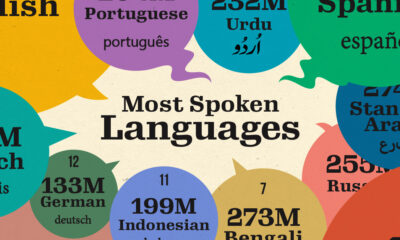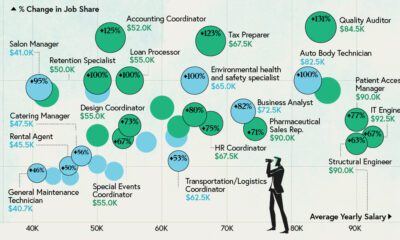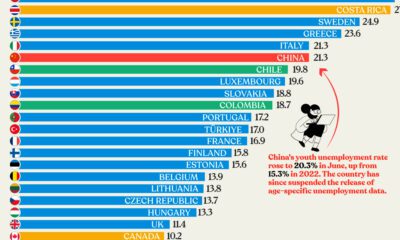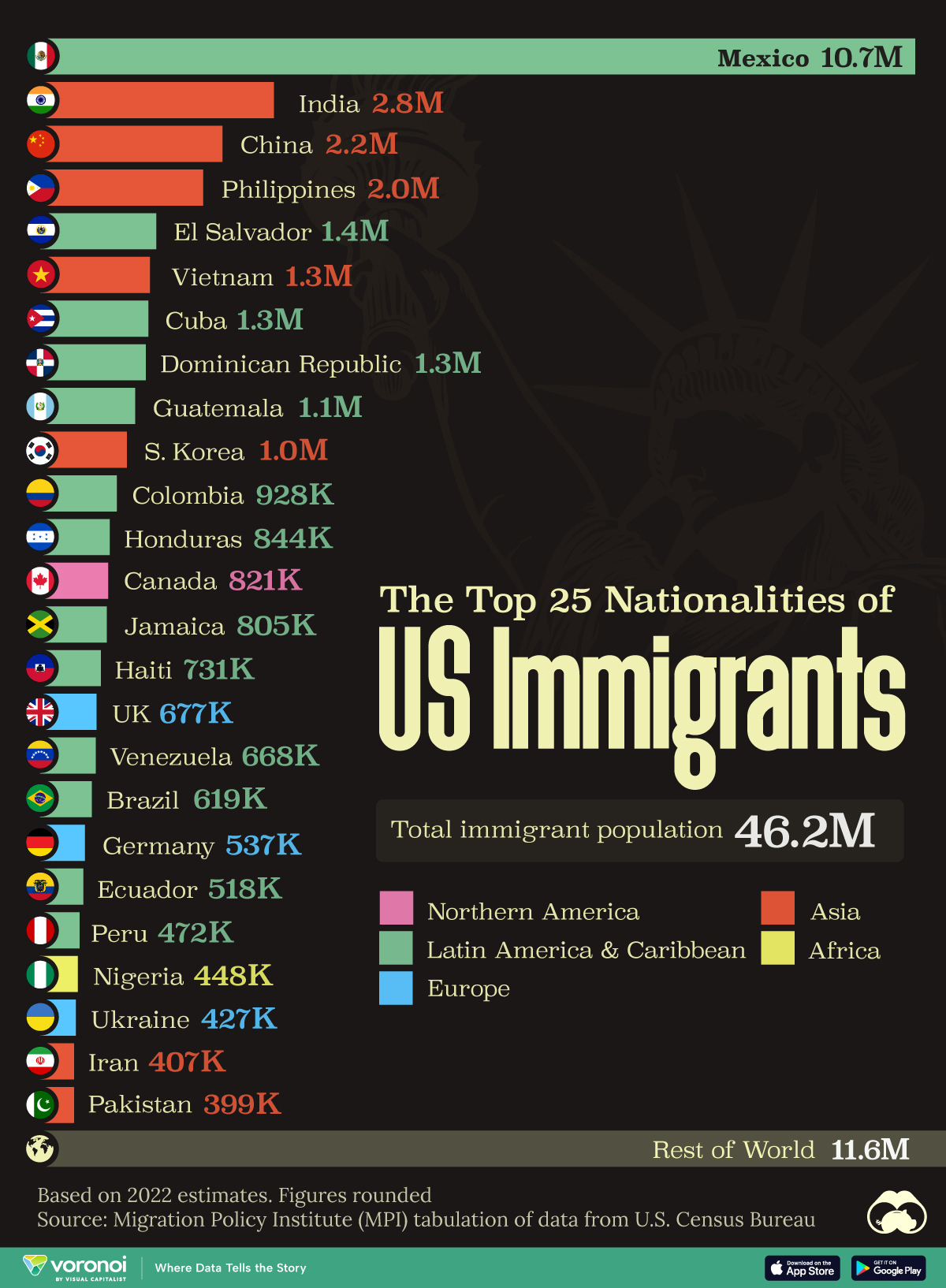Misc
Which U.S. College Major is the Worst for Finding a Job?
![]() See this visualization first on the Voronoi app.
See this visualization first on the Voronoi app.
Which U.S. College Major is the Worst for Finding a Job?
This was originally posted on our Voronoi app. Download the app for free on Apple or Android and discover incredible data-driven charts from a variety of trusted sources.
Finding a job can often be a Sisyphean task in this rapidly changing modern economy. Highly sought after skills come and go, following the greater tides of technology change, marketplace behavior, and shifting consumer patterns.
After all, take a look at what’s happening in the tech world.
Education plays an important role in this job hunting business of course. And some skill sets are losing their sheen, with their practitioners having a harder time than others in securing gainful employment.
But which ones are the worst right now?
We visualize the top 10 U.S. college majors, ranked by their unemployment rate, including their underemployment rate for additional context. These figures are of recent college graduates (those aged 22–27 with a bachelor’s degree or higher) and are sourced from the New York Federal Reserve, current up to February 2024.
Ranked: U.S. Majors with the Highest Unemployment Rates
Heading the first three spots on this list are all the majors with “art” in their name.
Nearly 8% of recent Art History, Liberal Arts, and Fine Arts graduates are unemployed, with more than 50% of them underemployed.
| Rank | U.S. Major | Unemployment Rate | Underemployment Rate |
|---|---|---|---|
| 1 | 🎨 Art History | 8.0% | 62.3% |
| 2 | 📘 Liberal Arts | 7.9% | 56.7% |
| 3 | 🖌️ Fine Arts | 7.9% | 55.5% |
| 4 | 🚀 Aerospace Engineering | 7.8% | 17.9% |
| 5 | 📜 History | 7.5% | 53.5% |
| 6 | 📚 English Language | 6.6% | 48.4% |
| 7 | 📺 Mass Media | 6.3% | 47.7% |
| 8 | 🔬 Physics | 6.2% | 31.2% |
| 9 | 🎨 Commercial Art & Graphic Design | 6.0% | 33.7% |
| 10 | 👥 Sociology | 5.5% | 49.6% |
| N/A | 📉 Average Rate | 3.5% | 40.3% |
At fourth place, 7.8% of recent Aerospace Engineering majors have not found a job—a surprising statistic since engineering is regarded as one of the more stable majors to study.
In fact from same data source, Industrial and Mechanical engineers have some of the lowest unemployment rates in the country.
However, aerospace engineering jobs tend to be clustered around the big companies in an otherwise small industry, with additional requirements for security clearances. Tellingly, the underemployment rate for aerospace engineering graduates is less than 20%, which is the best out of this list.
At fifth, sixth, and seventh place are History (7.5%), English (6.6%), and Mass Media (6.3%) of which the former two have also seen a rapid decline in undergraduates in the last decade.
Misc
The Top 25 Nationalities of U.S. Immigrants
Mexico is the largest source of immigrants to the U.S., with almost 11 million immigrants.
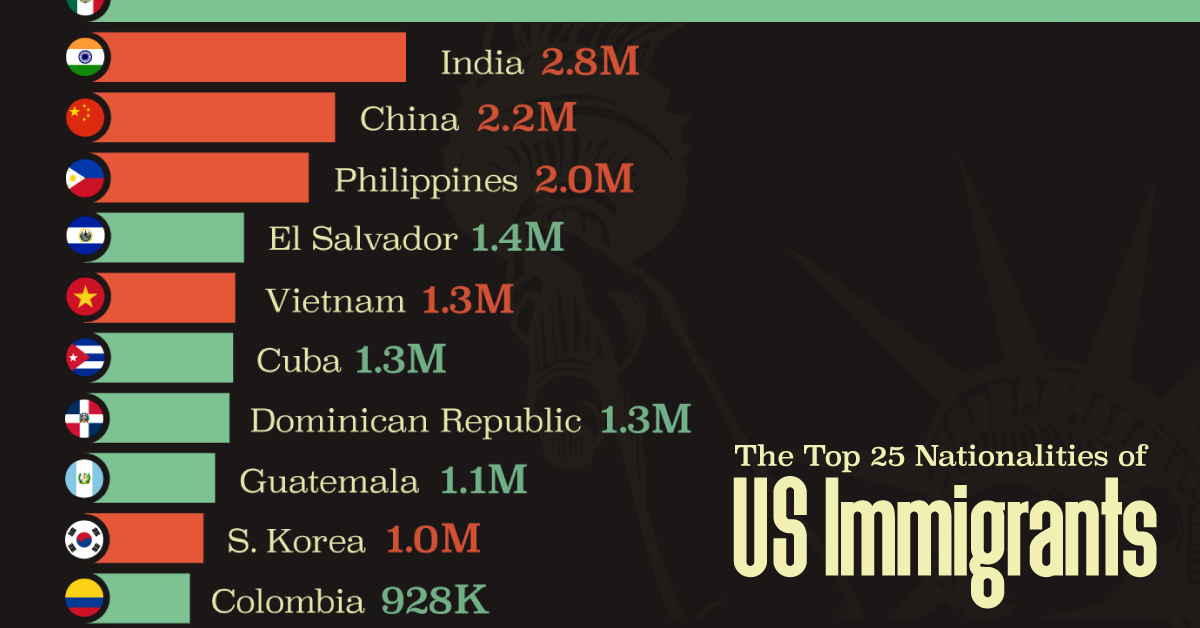
The Top 25 Nationalities of U.S. Immigrants
This was originally posted on our Voronoi app. Download the app for free on iOS or Android and discover incredible data-driven charts from a variety of trusted sources.
The United States is home to more than 46 million immigrants, constituting approximately 14% of its total population.
This graphic displays the top 25 countries of origin for U.S. immigrants, based on 2022 estimates. The data is sourced from the Migration Policy Institute (MPI), which analyzed information from the U.S. Census Bureau’s 2022 American Community Survey.
In this context, “immigrants” refer to individuals residing in the United States who were not U.S. citizens at birth.
Mexico Emerges as a Leading Source of Immigration
Mexico stands out as the largest contributor to U.S. immigration due to its geographical proximity and historical ties.
Various economic factors, including wage disparities and employment opportunities, motivate many Mexicans to seek better prospects north of the border.
| Country | Region | # of Immigrants |
|---|---|---|
| 🇲🇽 Mexico | Latin America & Caribbean | 10,678,502 |
| 🇮🇳 India | Asia | 2,839,618 |
| 🇨🇳 China | Asia | 2,217,894 |
| 🇵🇭 Philippines | Asia | 1,982,333 |
| 🇸🇻 El Salvador | Latin America & Caribbean | 1,407,622 |
| 🇻🇳 Vietnam | Asia | 1,331,192 |
| 🇨🇺 Cuba | Latin America & Caribbean | 1,312,510 |
| 🇩🇴 Dominican Republic | Latin America & Caribbean | 1,279,900 |
| 🇬🇹 Guatemala | Latin America & Caribbean | 1,148,543 |
| 🇰🇷 Korea | Asia | 1,045,100 |
| 🇨🇴 Colombia | Latin America & Caribbean | 928,053 |
| 🇭🇳 Honduras | Latin America & Caribbean | 843,774 |
| 🇨🇦 Canada | Northern America | 821,322 |
| 🇯🇲 Jamaica | Latin America & Caribbean | 804,775 |
| 🇭🇹 Haiti | Latin America & Caribbean | 730,780 |
| 🇬🇧 United Kingdom | Europe | 676,652 |
| 🇻🇪 Venezuela | Latin America & Caribbean | 667,664 |
| 🇧🇷 Brazil | Latin America & Caribbean | 618,525 |
| 🇩🇪 Germany | Europe | 537,484 |
| 🇪🇨 Ecuador | Latin America & Caribbean | 518,287 |
| 🇵🇪 Peru | Latin America & Caribbean | 471,988 |
| 🇳🇬 Nigeria | Africa | 448,405 |
| 🇺🇦 Ukraine | Europe | 427,163 |
| 🇮🇷 Iran | Middle East | 407,283 |
| 🇵🇰 Pakistan | Asia | 399,086 |
| Rest of World | 11,637,634 | |
| Total | 46,182,089 |
Mexicans are followed in this ranking by Indians, Chinese, and Filipinos, though most immigrants on this list come from countries in the Latin American and Caribbean region.
On the other hand, only three European countries are among the top sources of U.S. immigrants: the UK, Germany, and Ukraine.
Immigration continues to be a significant factor contributing to the overall growth of the U.S. population. Overall population growth has decelerated over the past decade primarily due to declining birth rates.
Between 2021 and 2022, the increase in the immigrant population accounted for 65% of the total population growth in the U.S., representing 912,000 individuals out of nearly 1.4 million.
If you enjoyed this post, be sure to check out Visualized: Why Do People Immigrate to the U.S.? This visualization shows the different reasons cited by new arrivals to America in 2021.
-

 Personal Finance1 week ago
Personal Finance1 week agoVisualizing the Tax Burden of Every U.S. State
-

 Misc6 days ago
Misc6 days agoVisualized: Aircraft Carriers by Country
-

 Culture6 days ago
Culture6 days agoHow Popular Snack Brand Logos Have Changed
-

 Mining1 week ago
Mining1 week agoVisualizing Copper Production by Country in 2023
-

 Misc1 week ago
Misc1 week agoCharted: How Americans Feel About Federal Government Agencies
-

 Healthcare1 week ago
Healthcare1 week agoWhich Countries Have the Highest Infant Mortality Rates?
-

 Demographics1 week ago
Demographics1 week agoMapped: U.S. Immigrants by Region
-

 Maps1 week ago
Maps1 week agoMapped: Southeast Asia’s GDP Per Capita, by Country

